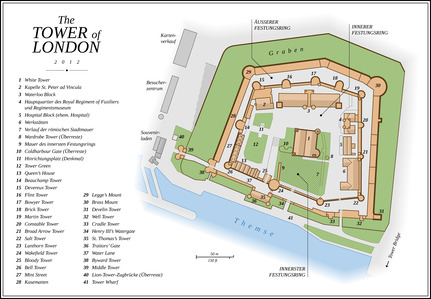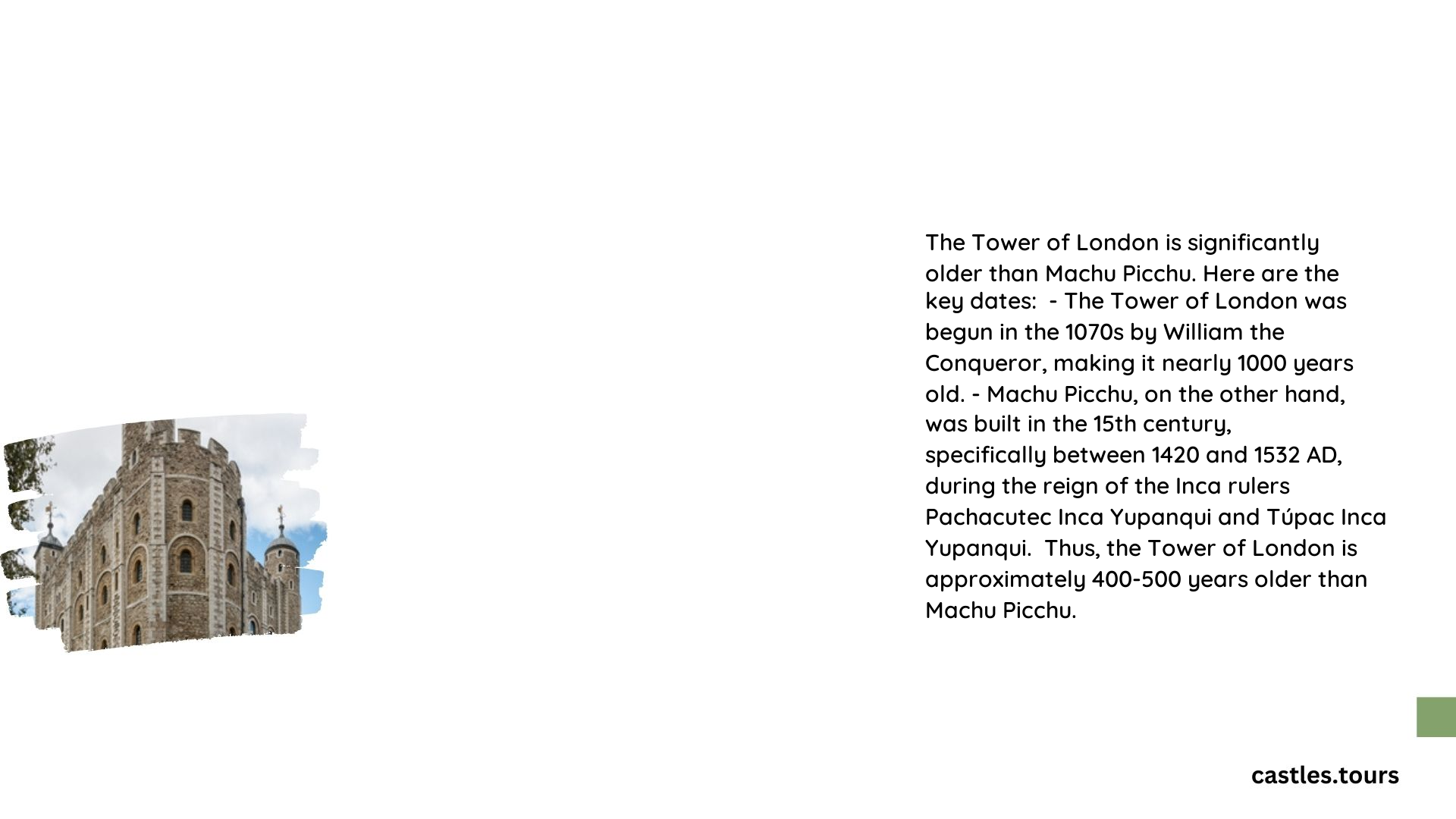The Tower of London, a historic castle and fortress on the north bank of the River Thames in central London, predates Machu Picchu by nearly 400 years. Founded in 1066 by William the Conqueror, the Tower has played a crucial role in English history for over 950 years. Its White Tower, the central keep, was built around 1078, while Machu Picchu was constructed around 1450 AD. This significant age difference highlights the Tower’s enduring presence in European history and architecture.
Why Is the Tower of London Considered Older Than Machu Picchu?

The Tower of London’s age superiority over Machu Picchu can be attributed to several factors:
- Foundation Date: The Tower was founded in 1066, nearly 400 years before Machu Picchu’s construction began.
- Completion of Key Structures: The White Tower, completed around 1100, predates Machu Picchu by over 350 years.
- Continuous Occupation: The Tower has been in continuous use since its construction, unlike Machu Picchu which was abandoned in the 16th century.
What Are the Key Historical Periods of the Tower of London?

The Tower of London’s history spans nearly a millennium, encompassing several key periods:
- Norman Conquest (1066-1154)
- Plantagenet Era (1154-1485)
- Tudor Period (1485-1603)
- Stuart Reign (1603-1714)
- Georgian Era (1714-1837)
- Victorian Age (1837-1901)
- Modern Era (1901-present)
Each of these periods contributed to the Tower’s evolving role and significance in English history.
How Does the Architecture of the Tower of London Compare to Machu Picchu?
The architectural differences between the Tower of London and Machu Picchu reflect their distinct cultural origins and purposes:
| Feature | Tower of London | Machu Picchu |
|---|---|---|
| Building Material | Stone masonry with mortar | Dry-stone technique without mortar |
| Architectural Style | Norman and Medieval European | Inca classical style |
| Primary Function | Fortress and royal residence | Religious and administrative center |
| Layout | Concentric castle design | Terraced city layout |
| Defensive Features | Moat, curtain walls, towers | Natural mountain defenses, steep terraces |
What Unique Features Make the Tower of London Stand Out?
The Tower of London boasts several unique features that set it apart:
- The White Tower: The oldest part of the complex, symbolizing Norman power.
- Crown Jewels: Home to the British Crown Jewels since the 14th century.
- Yeoman Warders: Ceremonial guardians, also known as “Beefeaters.”
- Ravens: Legend states that if the ravens leave, the kingdom will fall.
- Traitors’ Gate: Water-gate entrance for prisoners arriving by boat.
How Has the Tower of London’s Role Evolved Over Time?
The Tower’s functions have changed significantly over the centuries:
- 11th-14th centuries: Royal residence and fortress
- 15th-16th centuries: Prison for high-status and religious prisoners
- 17th-19th centuries: Armory, treasury, and home of the Royal Mint
- 20th century to present: Museum and tourist attraction
This evolution reflects the changing needs of the English monarchy and society.
What Historical Events Occurred at the Tower of London Before Machu Picchu’s Construction?
Several significant events took place at the Tower before Machu Picchu was built:
- Imprisonment of King John’s nephew, Arthur of Brittany (1203)
- Addition of the Bloody Tower (1220s)
- Expansion of the castle’s defenses by Henry III (1230s)
- Construction of St. Thomas’s Tower and Traitors’ Gate (1275-1279)
- Peasants’ Revolt siege (1381)
- Imprisonment of the Princes in the Tower (1483)
These events underscore the Tower’s importance in English history long before Machu Picchu’s existence.
How Does the Cultural Significance of the Tower of London Compare to Machu Picchu?
Both sites hold immense cultural significance, but in different contexts:
- Tower of London:
- Symbol of Norman conquest and English monarchy
- Witness to key events in British history
-
Represents the evolution of European military architecture
-
Machu Picchu:
- Testament to Inca civilization’s engineering prowess
- Spiritual and astronomical significance
- Symbol of pre-Columbian culture in South America
While both are UNESCO World Heritage Sites, the Tower’s longer history and continuous use give it a unique place in Western cultural heritage.
What Conservation Efforts Ensure the Tower of London’s Longevity?
To preserve the Tower for future generations, several conservation efforts are ongoing:
- Regular structural assessments and repairs
- Climate control measures for artifacts and buildings
- Visitor management to reduce wear and tear
- Documentation and research to inform preservation strategies
- Educational programs to raise awareness of the site’s historical importance
These efforts aim to maintain the Tower’s integrity while allowing public access to this historic landmark.
References:
– https://artsandculture.google.com/story/8-things-you-need-to-know-about-the-tower-of-london-historic-royal-palaces/eAVxSyLgG1zf4Q?hl=en
– https://en.wikipedia.org/wiki/Tower_of_london
– https://whc.unesco.org/en/list/488/
– https://www.hrp.org.uk/media/1171/tolhistory_v1.pdf
– https://evanevanstours.com/travel-guide/london-guide/tower-of-london-guide/
